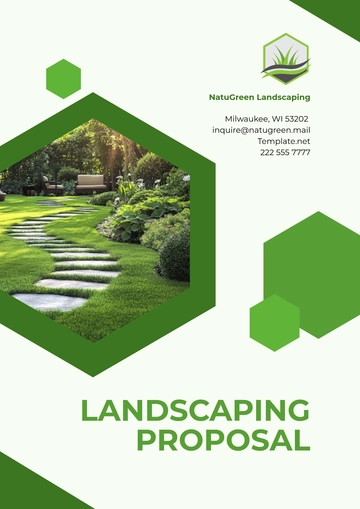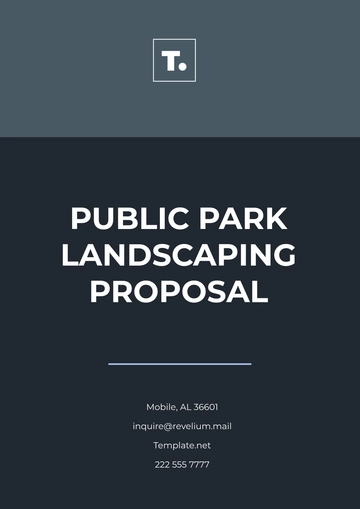Free Golf Course Landscaping Proposal

Prepared by: [Your Name]
Date: [Date]
I. Introduction
This proposal outlines the plan for enhancing the landscaping of the Greenview Golf Course. Our goal is to create a sustainable and aesthetically pleasing landscape that not only improves the overall playing experience but also promotes environmental responsibility. The project will focus on turf management, plant selection, irrigation, and maintenance strategies to ensure long-term viability.
II. Site Analysis
A. Current Landscape
Greenview Golf Course spans over 150 acres with a combination of open fairways, sand traps, water features, and wooded areas. The existing landscape features a mix of mature trees, native plants, and areas that are underutilized or poorly maintained.
B. Soil and Climate Conditions
The soil across the course varies from sandy to loamy, which is suitable for turf growth but requires careful irrigation management. The climate in the region is temperate, with moderate rainfall and seasonal temperature variations, ideal for a range of grasses and plants.
C. Environmental Considerations
We aim to incorporate sustainable practices, including water-efficient irrigation systems and drought-resistant plant species, to minimize the environmental impact of landscaping on the course.
III. Design Plan
A. Turf Management
We propose transitioning to drought-resistant turf varieties such as Bermuda grass for the fairways and tees, which will reduce water usage and maintenance costs. Additionally, rough areas will be seeded with native grasses to encourage biodiversity.
B. Plant Selection
A mix of native and ornamental plants will be used along the course's edges, bunkers, and water features. We will select plants that enhance visual appeal while promoting sustainability, such as flowering shrubs and grasses that require minimal irrigation once established.
C. Irrigation System
A state-of-the-art, water-efficient irrigation system will be installed to ensure the optimal use of water resources. Smart controllers will adjust water schedules based on weather conditions, ensuring that each area receives the appropriate amount of water.
D. Pathways and Features
We will enhance walking paths and cart trails with natural materials, such as gravel and flagstone, to blend with the surrounding landscape. New features like decorative fountains and ponds will be incorporated to increase the course’s aesthetic appeal.
IV. Implementation Timeline
A. Phase 1: Design and Planning (1-2 Months)
Finalize design concepts and plant selections
Conduct site assessments and prepare the area for installation
B. Phase 2: Landscaping Installation (3-4 Months)
Begin turf installation and soil preparation
Install irrigation system and landscape features
Plant selected shrubs, grasses, and trees
C. Phase 3: Final Touches and Inspection (1 Month)
Complete remaining landscaping elements
Perform an inspection to ensure everything is in place and functioning properly.
V. Budget and Costs
A. Turf Management and Soil Preparation
Bermuda grass turf: $15,000
Soil preparation and aeration: $8,000
B. Irrigation System Installation
Smart irrigation system: $25,000
Labor and materials: $10,000
C. Planting and Landscaping Features
Native plants and shrubs: $5,000
Water features and fountains: $12,000
D. Labor and Miscellaneous Costs
Landscaping labor: $20,000
Contingency fund: $5,000
Total Estimated Budget: $100,000
VI. Maintenance Plan
A. Long-Term Care
The landscape will be maintained with periodic checks on irrigation systems, turf health, and plant vitality. Regular mowing, trimming, and seasonal adjustments will ensure the landscape remains in optimal condition.
B. Environmental Sustainability
We will continue to monitor water usage and adjust irrigation systems as needed to ensure minimal environmental impact. Regular assessments will help identify opportunities for further sustainability improvements.
C. Annual Review
An annual review of the landscaping plan will be conducted to assess its success and determine areas for improvement. This will ensure that the course remains visually appealing and ecologically sustainable year-round.
- 100% Customizable, free editor
- Access 1 Million+ Templates, photo’s & graphics
- Download or share as a template
- Click and replace photos, graphics, text, backgrounds
- Resize, crop, AI write & more
- Access advanced editor
Template.net’s Golf Course Landscaping Proposal Template is ideal for landscapers working on golf course maintenance or redesign projects. Fully editable and customizable, this template lets you detail landscape designs, turf management, and course aesthetics. Use our Ai Editor Tool to personalize every element of your proposal, ensuring it aligns with the unique needs of golf course clients.
You may also like
- Business Proposal
- Research Proposal
- Proposal Request
- Project Proposal
- Grant Proposal
- Photography Proposal
- Job Proposal
- Budget Proposal
- Marketing Proposal
- Branding Proposal
- Advertising Proposal
- Sales Proposal
- Startup Proposal
- Event Proposal
- Creative Proposal
- Restaurant Proposal
- Blank Proposal
- One Page Proposal
- Proposal Report
- IT Proposal
- Non Profit Proposal
- Training Proposal
- Construction Proposal
- School Proposal
- Cleaning Proposal
- Contract Proposal
- HR Proposal
- Travel Agency Proposal
- Small Business Proposal
- Investment Proposal
- Bid Proposal
- Retail Business Proposal
- Sponsorship Proposal
- Academic Proposal
- Partnership Proposal
- Work Proposal
- Agency Proposal
- University Proposal
- Accounting Proposal
- Real Estate Proposal
- Hotel Proposal
- Product Proposal
- Advertising Agency Proposal
- Development Proposal
- Loan Proposal
- Website Proposal
- Nursing Home Proposal
- Financial Proposal
- Salon Proposal
- Freelancer Proposal
- Funding Proposal
- Work from Home Proposal
- Company Proposal
- Consulting Proposal
- Educational Proposal
- Construction Bid Proposal
- Interior Design Proposal
- New Product Proposal
- Sports Proposal
- Corporate Proposal
- Food Proposal
- Property Proposal
- Maintenance Proposal
- Purchase Proposal
- Rental Proposal
- Recruitment Proposal
- Social Media Proposal
- Travel Proposal
- Trip Proposal
- Software Proposal
- Conference Proposal
- Graphic Design Proposal
- Law Firm Proposal
- Medical Proposal
- Music Proposal
- Pricing Proposal
- SEO Proposal
- Strategy Proposal
- Technical Proposal
- Coaching Proposal
- Ecommerce Proposal
- Fundraising Proposal
- Landscaping Proposal
- Charity Proposal
- Contractor Proposal
- Exhibition Proposal
- Art Proposal
- Mobile Proposal
- Equipment Proposal
- Student Proposal
- Engineering Proposal
- Business Proposal





























